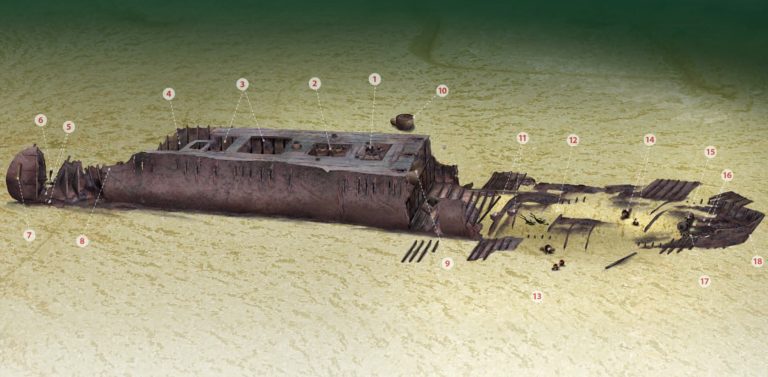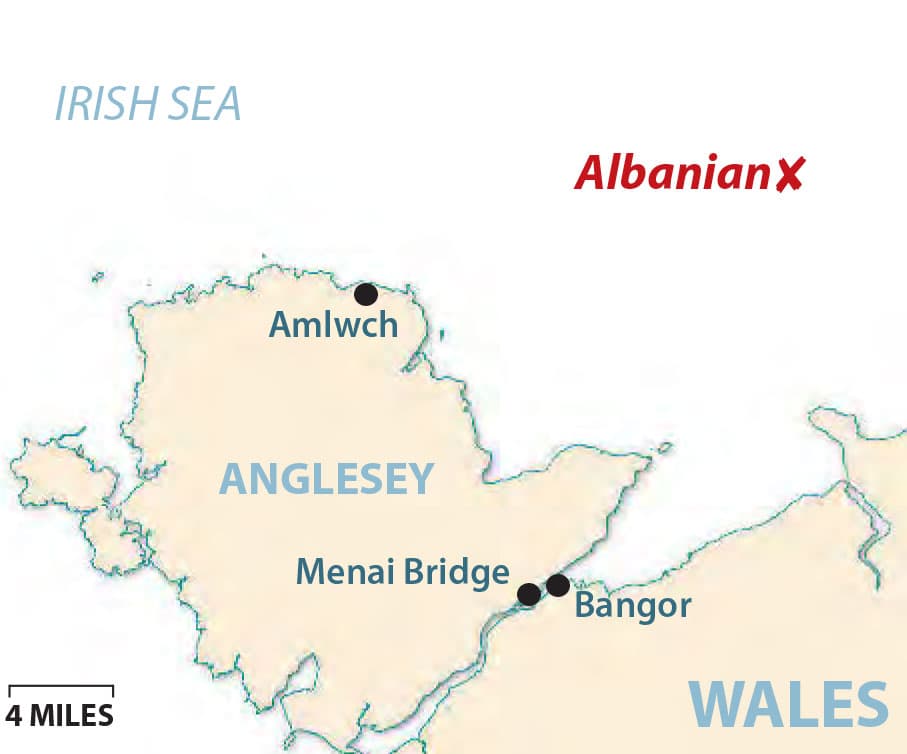This slightly deeper steamer wreck, sunk off Anglesey in the 19th century, offers divers a wide variety of intriguing cargo to inspect. JOHN LIDDIARD conducts the tour, which is illustrated by MAX ELLIS
THIS MONTH’S TOUR OF THE 1417-ton steamship Albanian is one of another North Wales pair sunk in a collision, the associated wreck of the Nydia being only a couple of miles away.
My host and skipper Scott Waterman dropped the shot across the intact part of the hull, close to the break to the forward holds. As a shot rarely lands in exactly the same place twice, I will begin our tour heading aft from the break at 31m.
This actually starts our dive with the shallower aft part of the wreck, but if you don’t make it all the way round, you will at least have seen the interesting piles of cargo.
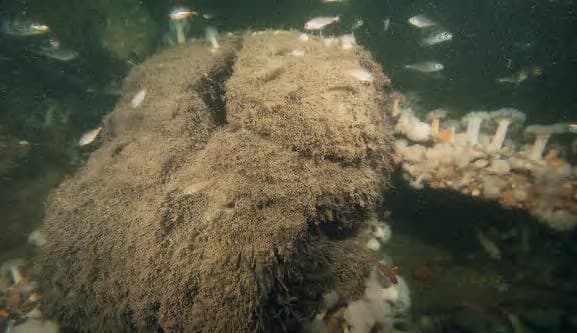
The first significant hole in the wooden deck is the flue from the boilers (1), the hole below now blocked with debris.
Immediately aft of this, a longer rectangular hole shows the top of the two-cylinder compound engine (2).
Built in 1870, the Albanian comes from an age in which shipbuilders were being creative with “new” technologies, and steamship engineering had not converged to the extent it had only a decade later.
A notable feature of the Albanian is an inverted compound engine. The crankshaft is still at
the bottom of the engine, but the upright pistons are driven from steam entering below them rather than from above, hence “inverted”.
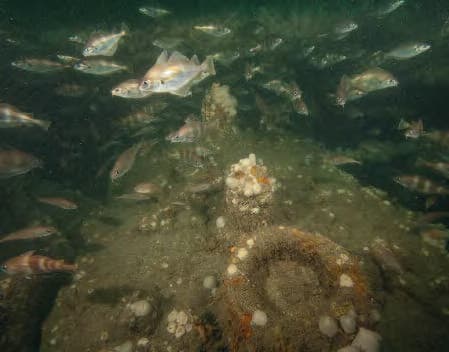
As an aside, a further variation was “double-acting”, in which both faces of a piston would alternately be driven by steam. Unfortunately for those with engineering curiosity, the space around the heads of the
cylinders is very tight and the surrounding deck fairly intact, so you can’t look in to see the details of the machinery below.
It’s one of those rare occasions on which I could wish that a wreck was more broken up. Behind the engine-room is the iron socket from the foot of a wooden mast.
Then the next big rectangular opening is the first hold aft (3). This hold is intact and silted, so I will leave describing the cargo to the aft-most hold (4), where the hull is now broken with the aft bulkhead of the hold. Peering into the piled cargo, it is possible to pick out barrels, copper pipe, bales of cloth from the Lancashire mills and large blue glass jars. Whether these were once full and used to transport a liquid cargo, or whether the jars themselves were the cargo, I do not know.
Descending the slope of cargo to the broken stern, we first pass a section of deck tipped on end (5) with pairs of bollards sticking out to the starboard side of the wreck.
Beneath this, the stub of the propeller-shaft descends into the silt and debris, with one long iron blade standing from the 41m-deep seabed (6).
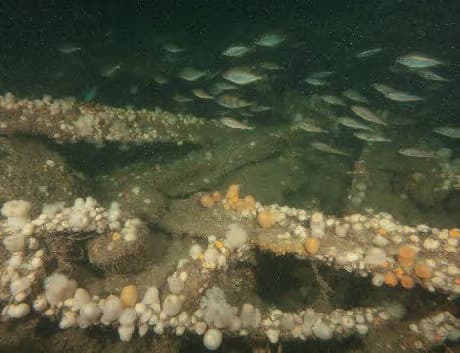
Rounding the stern to the deck side, at the top of the rudder-post a single tiller-arm (7) points upwards – another piece of engineering soon superseded by quadrant steering on steamships of this size.
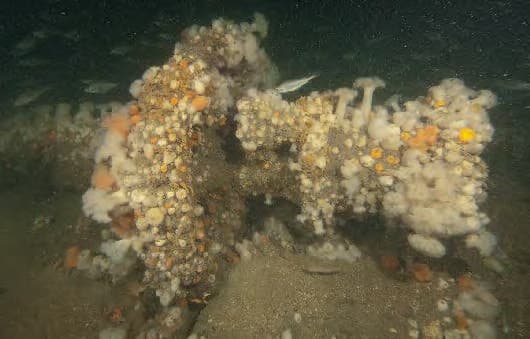
Retracing our route forwards, the ascent of the pile of cargo (8) provides an opportunity to examine it from another perspective. A different point of view can often lead to new discoveries for those who like to rummage.
Back past the engine to our starting point and the break across the hull, descending the bulkhead reveals a pair of boilers (9) secured inside. Looking in, you can see the domed steam-dryers located above the far end of the boilers.
Rather than heading straight forwards, here is an opportunity to divert to port, where another cylindrical domed structure stands up from the seabed alongside the wreck (10).
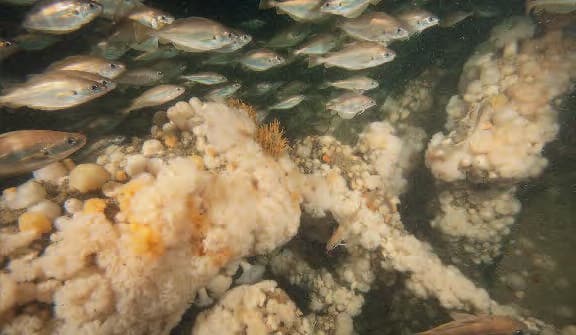
I suspect that this was a donkey boiler originally located above the main boilers.
Returning to the route forwards, the last upright section of the hull stands to starboard, and just forward of that are more bales of cloth (11) from the cargo.
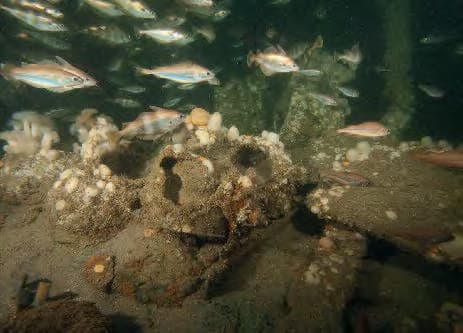
The wreck is now well broken, with hull-plates visible to port and a 3m-high mound of sand and debris (12) along the centre-line.
Following round the starboard side of this mound, the broken shaft of a cargo-winch (13) is off to the side, then more parts of the winch (14) closer to the centre-line as the mound of sand descends to the bow.
The first sign of the bow is the anchor-winch (15), fallen back with a section of deck and the hawse-pipes (16) leading forwards. There is also a section of chain (17) draped round the starboard side of the bow, suggesting that the anchors had been pulled on board but not yet detached from the chain, as ships of this era would do on a long voyage.
The final point of our tour is the raked bow (18), a shape about halfway between that of a sailing ship and the straight blunt bow that later steamships would adopt.
After a long dive, this may be a good place to release a delayed SMB for a drifting decompression. Or you could return to the shallower part of the wreck, but that brings me to another reason that our tour has been back-to-front.
With the mound of sand drifted across the wreck, finding your way back may not be that easy.
CLASH OF SAIL AND STEAM
THE ALBANIAN, cargo steamer. BUILT 1870, SUNK 1877
AN EARLY IRON-HULLED STEAMSHIP, the 1417-ton Albanian was built in 1870 by T Royden & Sons of Liverpool, and used by the Liverpool-based Bibby Line for Iberian and Mediterranean trade.
At 9am on 18 November, 1877, the Albanian left Liverpool for Genoa and then Leghorn in Italy with 1300 tons of general cargo.
Also departing from Liverpool was the 834-ton wooden barque Nydia, built by P Valin of Quebec in 1853. By 1877 she was owned by JP Evans of Liverpool. The Nydia left at 8.15pm on 17 November, in ballast for Tyree.
With two ships heading in roughly the same direction, you might not expect a serious collision. But that
would ignore the difference between sail and steam. Steam ships can steer a straight course, while sailing ships often steer wide tacks according to the wind.
About half an hour after noon, the third officer Hugh Penny was in command of the Albanian, and Captain Thomas Lloyd and the other officers were below deck, perhaps having their lunch. Similarly, the officers and pilot on the Nydia were taking turns to go below deck for their own meal.
The conditions were clear and the Nydia was sighted some two miles away, on a course destined to cross that of the Albanian at right-angles.
With other steamships crossing her course behind the Nydia, options to change course were limited.
As the Albanian approached, the pilot on the Nydia ordered the ship kept close to the wind.
Third Officer Penny made no attempt to adjust the Albanian’s course, and the Nydia subsequently struck her port side, just forward of the bridge. The Albanian‘s hull was stove in and the Nydia‘s bow smashed.
At the subsequent Board of Trade enquiry, Third Officer Penny was found to be wholly responsible for the collision, through holding course and attempting to cross forward of the Nydia rather than taking avoiding action. The ships sank within a couple of miles of each other.
TOUR GUIDE
GETTING THERE: Follow the A55 across North Wales to Anglesey and across the Menai Bridge. Take the first slip-road and turn right to the town of Menai Bridge.
Turn towards the waterfront by the newsagent and post office opposite HSBC, and head for the pontoon by the harbour office.
HOW TO FIND IT: The GPS co-ordinates are 53 28.947N, 003 53.807W (degrees, minutes and decimals). The bow points south-east.
TIDES: Slack water is essential, and occurs 30 minutes before high or low water Liverpool.
DIVING & AIR: Quest Diving Charters operates from Menai Bridge, 01248 716923
ACCOMMODATION: Anglesey tourist information.
LAUNCHING: Slipways are available at Menai Bridge, Amlwch, Conwy and Colwyn Bay.
QUALIFICATIONS: Ideally suited to divers with a basic technical qualification such as Advanced Nitrox or Decompression Procedures. The wreck is within the range of a BSAC Dive Leader or PADI Deep speciality.
FURTHER INFORMATION: Admiralty Chart 1977, Holyhead to Great Ormes Head. Ordnance Survey
114, Anglesey. Shipwreck Index of the British Isles, Volume 5, West Coast & Wales, Richard & Bridget Larn. Board of Trade Report.
PROS: There is a huge variety of cargo to inspect.
CONS: Spans a depth range where less-experienced and less-qualified divers could be tempted beyond their qualifications.
DEPTH: 35-45m
Thanks to Scott Waterman.
